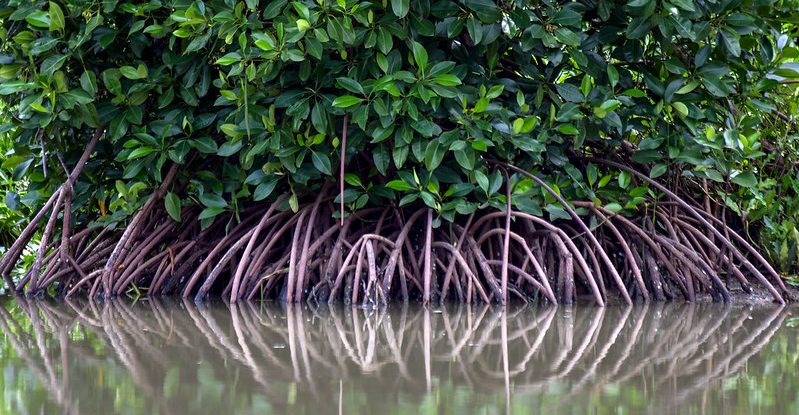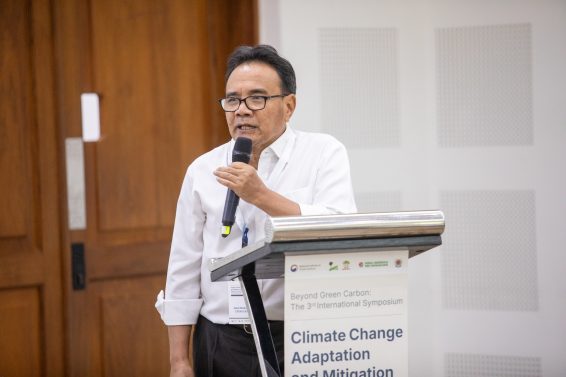
South Korea’s Jeju Island is famous for many things: its volcanic landscape, white-sand beaches, haenyeo (woman divers), and abundant produce. It’s less well-known for its mangroves – though that could soon change.
Two native ‘semi-mangrove’ species are found there: Hibiscus hamabo and Paliurus ramosissimus. Adaptable to both intertidal zones and terrestrial habitats, these species lack the typical mangrove traits of aerial roots and unique seed germination, but offer similarly high potential for carbon absorption, climate change mitigation, biodiversity, livelihoods, and coastal protection as their ‘true mangrove’ counterparts. Climate change is also tipped to bring more mangrove species to the country, as warmer temperatures start to make for a more hospitable home for these subtropical trees.
On 29 April 2024, researchers from South Korea and Indonesia gathered at the Centre for International Forestry Research and World Agroforestry (CIFOR-ICRAF) headquarters in Bogor to share learnings on making the most of mangroves’ climate change mitigation and adaptation potential. “Mangrove forests are very, very carbon-dense ecosystems,” said Christopher Martius, principal scientist and leader of CIFOR-ICRAF’s Climate Change, Energy and Low-Carbon Development team, during introductory remarks at the event. “So when we destroy them, huge amounts of carbon go into the atmosphere.”
In line with this knowledge, mangrove restoration projects have proliferated in South Korea in recent years, according to Hyungsoon Choi, the head of South Korea’s National Institute of Forest Science (NIFoS)’ Jeju division. However, “there is not yet a lot of research to support it – so we need this collaborative effort between the two countries.” Cho Junkuy, director of the Korea-Indonesia Forest Cooperation Center, also shared hopes “that our collective effect will contribute to international cooperation in combating climate change.”

Hyungsoon Choi, the head of South Korea’s National Institute of Forest Science (NIFoS) Jeju division, speaks during the event. Photo by Bima Satria Yudha/CIFOR-ICRAF
Bora Lee, a researcher at NIFoS Jeju, shared findings from ongoing research into the carbon dynamics and storage within the island’s native semi-mangrove forests. The data, Lee said, may help support expansion of semi-mangrove areas, as well as potential introduction of new mangrove species – if, crucially, this aligns with local communities’ aspirations.
Milkah Royna, a student intern at CIFOR-ICRAF, discussed the importance of appropriate methodologies and protocols for assessing biomass and carbon content in mangrove forests – a particularly challenging task as most of the carbon in such forests sits below the ground. “This deep, carbon-rich soil cannot be neglected, so researchers’ decisions on how deep to sample become very important,” Royna cautioned.
As well as assessing mangroves’ potential, it’s also key to track their vulnerability, particularly in the face of land-use pressures and sea-level rise. In that vein, Phidju Marrin Sagala, a research consultant at CIFOR-ICRAF, shared information from his team’s research on coastal adaptation to climate change, which developed vulnerability indices to assess which areas require urgent adaptation measures, and inform the management of mangrove forests for the benefit of ecosystems and communities into the future. “Mangroves have an important role in the survival of both humans and nature,” he concluded.

Symposium delegates explore the CIFOR-ICRAF Bogor Campus. Photo by Bima Satria Yudha/CIFOR-ICRAF
As a case in point, Beni Okarda, a senior research officer at CIFOR-ICRAF, shared the story of a participatory action research project that aims to restore mangroves in South Sumatra, while benefiting the local community. includes nursery development, restoration sites, and a business model canvas to support small eco-enterprises. Through community engagement and collaboration with stakeholders, the project seeks to improve local capacity and promote sustainable mangrove restoration practices.
Hyungkyun Kim, project manager for the Korea-Indonesia Forest Cooperation Center, shared similarly about a peatland restoration project that the Center has supported in Jambi, Indonesia over the past two years, in collaboration with local universities and research institutes. He stressed the importance of scientific analysis, community involvement, and collaboration with stakeholders in achieving successful restoration outcomes.
Biophysical conditions, including moisture levels, also have a major impact on carbon sequestration and biomass accumulation in mangrove ecosystems, according to CIFOR-ICRAF researchers Citra Gilang and Agus Maulana. They emphasized the importance of selecting a diverse range of suitable species for restoration programmes, based on their environmental adaptability and carbon sequestration potential.
Of course, forests are more than just carbon sequestration machines. Mihyun Seol, a seconded scientist at CIFOR-ICRAF, spoke of their aesthetic values, and opportunities for meaningful recreational activities such as birdwatching, kayaking, and ecotourism. “If our services can be expanded to that recreational tourism, that would really allow people to get some pleasure from these ecosystems – and that’s important for their conservation, too,” she said.
Drawing the threads of discussion together following a series of incisive questions from the floor, CIFOR-ICRAF principal scientist Daniel Murdiyarso shared the recent innovation of the Blue Carbon Deck, a platform for community engagement and discussion on protection, monitoring and restoration of ‘blue carbon’ ecosystems such as mangroves, seagrass and saltmarsh.

CIFOR-ICRAF Principal Scientist Daniel Murdiyarso speaks during the event. Photo by Bima Satria Yudha/CIFOR-ICRAF
Murdiyarso also highlighted the necessity of addressing adaptation concerns before mitigation ones (focusing first on the needs of ecosystems and communities on the front lines of sea level rise), and protecting existing forests first of all. “Let’s conserve before we restore,” he said; “and when we restore, we need to have local people involved, so we can use restoration to improve their livelihoods and secure land ownership, too.”
For more information, please contact:
- Bora Lee, Warm-Temperate and Subtropical Forest Research Center, NIFoS Jeju, Republic of Korea: boralee7208@korea.kr
- Himlal Baral, CIFOR-ICRAF: h.baral@cifor-icraf.org
We want you to share Forests News content, which is licensed under Creative Commons Attribution-NonCommercial-ShareAlike 4.0 International (CC BY-NC-SA 4.0). This means you are free to redistribute our material for non-commercial purposes. All we ask is that you give Forests News appropriate credit and link to the original Forests News content, indicate if changes were made, and distribute your contributions under the same Creative Commons license. You must notify Forests News if you repost, reprint or reuse our materials by contacting forestsnews@cifor-icraf.org.